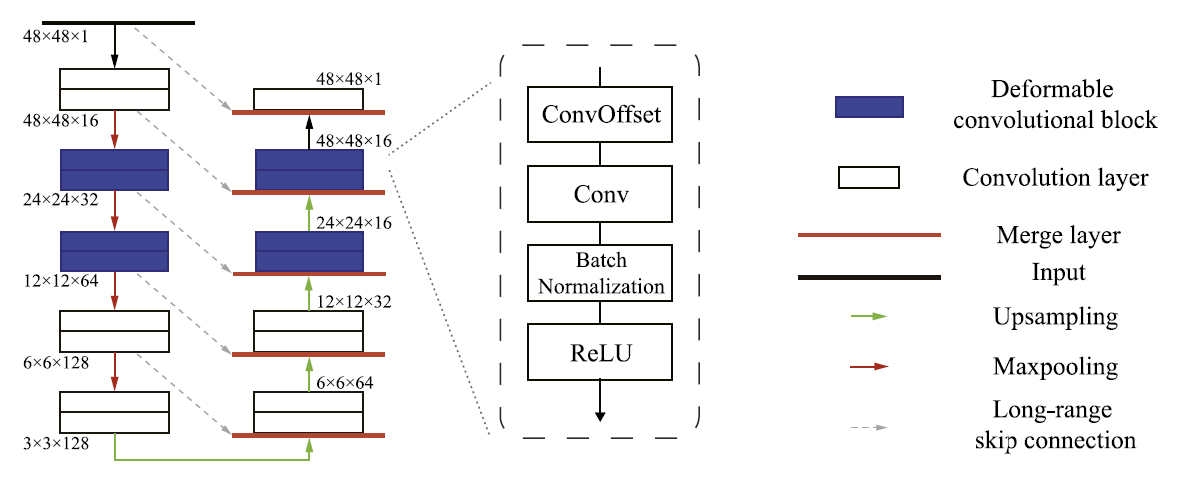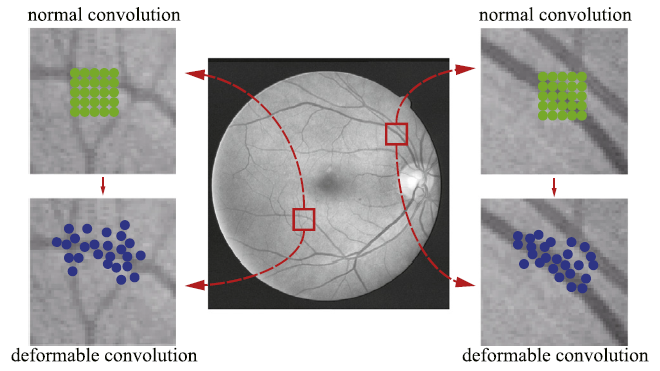
Review: DUNet — Deformable U-Net for Retinal Vessels Segmentation (Biomedical Image Segmentation)
Last Updated on July 20, 2023 by Editorial Team
Author(s): Sik-Ho Tsang
Originally published on Towards AI.
Technical Review of DUNet U+007C Towards AI
U-Net+DCN, Outperforms U-Net & DCN
In this story, DUNet, by Tianjin University, Linkoping University, and, is briefly reviewed.
DUNet, Deformable U-Net:
- exploits the retinal vessels’ local features with a U-shape architecture, with upsampling operators to extract context information.
- enable precise localization by combining low-level feature maps with high-level ones.
- captures the retinal vessels at various shapes and scales by adaptively adjusting the receptive fields according to vessels’ scales and shapes using the deformable convolutional network (DCN).
With DUNet, it is the potential to have an early diagnosis of diseases. It is published in 2019 JKNOSYS (Current Impact Factor: 5.101). (
Sik-Ho Tsang @ Medium)
Outline
- DUNet Architecture
- Experimental Results
1. DUNet Architecture

- The DUNet network architecture is as shown above.
- The architecture consists of a convolutional encoder (left side) and a decoder (right side) in a U-Net framework.
- In each encoding and decoding phase, deformable convolutional blocks are used to model retinal vessels of various shapes and scales through learning local, dense and adaptive receptive fields.

- Each deformable convolutional block consists of a convolution offset layer, which is the kernel concept of deformable convolution, a convolution layer, a batch normalization layer and an activation layer.

- Without DCN, For each grid point (green) in normal convolution, the receptive field is fixed:

- With DCN, for each grid point (blue) in normal convolution, Δmi (Δxi and Δyi) are learned to have the adaptive receptive field:

- (If interested, please read my review on DCN.)
- At the bottom of the DUNet, we use normal convolutional layers instead of the deformable blocks because a large number of parameters will be introduced without substantial performance improvement.
2. Experimental Results


- DUNet only requires 0.88M number of parameters which is fewer than U-Net.

- Compared with other approaches, DUNet obtains the best or comparable performance.

- The high-resolution HRF dataset is also tested as above.
- DUNet may fail in segmenting some thick vessels (yellow circles), these results are likely to be related to the low-resolution patches used for training.
- On the contrary, the DUNet successfully segmented the microvessels (blue circles).
By combining DCN and U-Net, DUNet is composed. (There are many results shown in the paper. Please feel free to read it by your own. Thanks 🙂
Reference
[2019 JKNOSYS] [DUNet]
DUNet: A deformable network for retinal vessel segmentation
My Previous Reviews
Image Classification [LeNet] [AlexNet] [Maxout] [NIN] [ZFNet] [VGGNet] [Highway] [SPPNet] [PReLU-Net] [STN] [DeepImage] [SqueezeNet] [GoogLeNet / Inception-v1] [BN-Inception / Inception-v2] [Inception-v3] [Inception-v4] [Xception] [MobileNetV1] [ResNet] [Pre-Activation ResNet] [RiR] [RoR] [Stochastic Depth] [WRN] [ResNet-38] [Shake-Shake] [FractalNet] [Trimps-Soushen] [PolyNet] [ResNeXt] [DenseNet] [PyramidNet] [DRN] [DPN] [Residual Attention Network] [DMRNet / DFN-MR] [IGCNet / IGCV1] [MSDNet] [ShuffleNet V1] [SENet] [NASNet] [MobileNetV2]
Object Detection [OverFeat] [R-CNN] [Fast R-CNN] [Faster R-CNN] [MR-CNN & S-CNN] [DeepID-Net] [CRAFT] [R-FCN] [ION] [MultiPathNet] [NoC] [Hikvision] [GBD-Net / GBD-v1 & GBD-v2] [G-RMI] [TDM] [SSD] [DSSD] [YOLOv1] [YOLOv2 / YOLO9000] [YOLOv3] [FPN] [RetinaNet] [DCN]
Semantic Segmentation [FCN] [DeconvNet] [DeepLabv1 & DeepLabv2] [CRF-RNN] [SegNet] [ParseNet] [DilatedNet] [DRN] [RefineNet] [GCN] [PSPNet] [DeepLabv3] [ResNet-38] [ResNet-DUC-HDC] [LC] [FC-DenseNet] [IDW-CNN] [DIS] [SDN] [DeepLabv3+]
Biomedical Image Segmentation [CUMedVision1] [CUMedVision2 / DCAN] [U-Net] [CFS-FCN] [U-Net+ResNet] [MultiChannel] [V-Net] [3D U-Net] [M²FCN] [SA] [QSA+QNT] [3D U-Net+ResNet] [Cascaded 3D U-Net] [Attention U-Net] [RU-Net & R2U-Net] [VoxResNet] [DenseVoxNet][UNet++] [H-DenseUNet] [DUNet]
Instance Segmentation [SDS] [Hypercolumn] [DeepMask] [SharpMask] [MultiPathNet] [MNC] [InstanceFCN] [FCIS]
Super Resolution [SRCNN] [FSRCNN] [VDSR] [ESPCN] [RED-Net] [DRCN] [DRRN] [LapSRN & MS-LapSRN] [SRDenseNet] [SR+STN]
Human Pose Estimation [DeepPose] [Tompson NIPS’14] [Tompson CVPR’15] [CPM]
Codec Post-Processing [ARCNN] [Lin DCC’16] [IFCNN] [Li ICME’17] [VRCNN] [DCAD] [DS-CNN]
Generative Adversarial Network [GAN]
Join thousands of data leaders on the AI newsletter. Join over 80,000 subscribers and keep up to date with the latest developments in AI. From research to projects and ideas. If you are building an AI startup, an AI-related product, or a service, we invite you to consider becoming a sponsor.
Published via Towards AI
Take our 90+ lesson From Beginner to Advanced LLM Developer Certification: From choosing a project to deploying a working product this is the most comprehensive and practical LLM course out there!
Towards AI has published Building LLMs for Production—our 470+ page guide to mastering LLMs with practical projects and expert insights!

Discover Your Dream AI Career at Towards AI Jobs
Towards AI has built a jobs board tailored specifically to Machine Learning and Data Science Jobs and Skills. Our software searches for live AI jobs each hour, labels and categorises them and makes them easily searchable. Explore over 40,000 live jobs today with Towards AI Jobs!
Note: Content contains the views of the contributing authors and not Towards AI.














